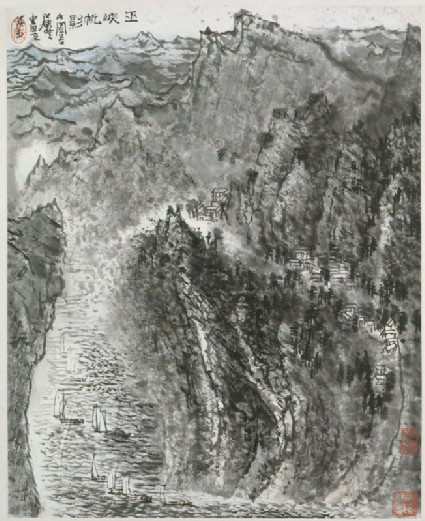Chinese Paintings in the Ashmolean Museum, Oxford
A catalogue of the Ashmolean collection of Chinese paintings by Shelagh Vainker (published Oxford, 2000).

Publications online: 222 objects
Sails in the Wu Gorges
-
Literature notes
Li Keran was born in Xuzhou in Jiangsu province. He attended art school in Shanghai at the age of fifteen, graduating in 1925, and later studied at the National Academy of Art in Hangzhou where his courses included sketching and oil painting. He spent somet time in Chongqing, Sichuan, during the Sino-Japanese War and in 1947 went to Beijing, where he spent ten years as a pupil of Qi Baishi (q.v.); he was also taught by Huang Binhong (q.v.). He himself taught at the Central Academy of Fine Arts. He had a successful career as an artist until the Cultural Revolution, and painted again from the late seventies until his death a decade later. -
Description
Li Keran was born in Xuzhou, Jiangsu province. He attended school in Shanghai, graduating in 1925, and later studied at the National Academy of Art in Hangzhou where his courses included sketching and oil painting. He spent some time in Sichuan province during the Sino-Japanese War, and in 1947 went to Beijing. He spent ten years as a pupil of Qi Baishi and Huang Binhong, the great masters of traditional painting. He himself taught at the Central Academy of Fine Arts in Beijing. He had a successful career as an artist until the Cultural Revolution, and painted again from the late 1970s until his death a decade later.
The landscape of the Wu Gorges was one of the artist’s favourite subjects in the 1960s, when he was not entirely satisfied with the contemporary trend of socialist realism in landscape painting. As stated in his seals, he was also seeking ‘the spirit’ and ‘emotions’ from this painting.
-
Details
- Associated place
- Date
- 1907 - 1964
- Artist/maker
-
Li Keran (1907 - 1989) (artist)
- Material and technique
- ink and colour on paper; mounted on layers of paper, framed with juan silk pieces; backed with paper scroll
- Dimensions
- 58.42 x 48.26 cm (height x width)
- Material index
-
organic › animal › animal product › silk
- Technique index
- Object type index
- No. of items
- 1
- Credit line
- Purchased, 1964.
- Accession no.
- EA1964.79
-
Further reading
Vainker, Shelagh, Chinese Paintings in the Ashmolean Museum, Oxford (Oxford: Ashmolean Museum, 2000), no. 73 on p. 92, illus. p. 93 fig. 73
Past Exhibition
see (1)Location
-
- currently in research collection
Objects are sometimes moved to a different location. Our object location data is usually updated on a monthly basis. Contact the Jameel Study Centre if you are planning to visit the museum to see a particular object on display, or would like to arrange an appointment to see an object in our reserve collections.
Publications online
-

Chinese Paintings in the Ashmolean Museum, Oxford
Li Keran was born in Xuzhou in Jiangsu province. He attended art school in Shanghai at the age of fifteen, graduating in 1925, and later studied at the National Academy of Art in Hangzhou where his courses included sketching and oil painting. He spent somet time in Chongqing, Sichuan, during the Sino-Japanese War and in 1947 went to Beijing, where he spent ten years as a pupil of Qi Baishi (q.v.); he was also taught by Huang Binhong (q.v.). He himself taught at the Central Academy of Fine Arts. He had a successful career as an artist until the Cultural Revolution, and painted again from the late seventies until his death a decade later.
Notice
Object information may not accurately reflect the actual contents of the original publication, since our online objects contain current information held in our collections database. Click on 'buy this publication' to purchase printed versions of our online publications, where available, or contact the Jameel Study Centre to arrange access to books on our collections that are now out of print.
© 2013 University of Oxford - Ashmolean Museum


